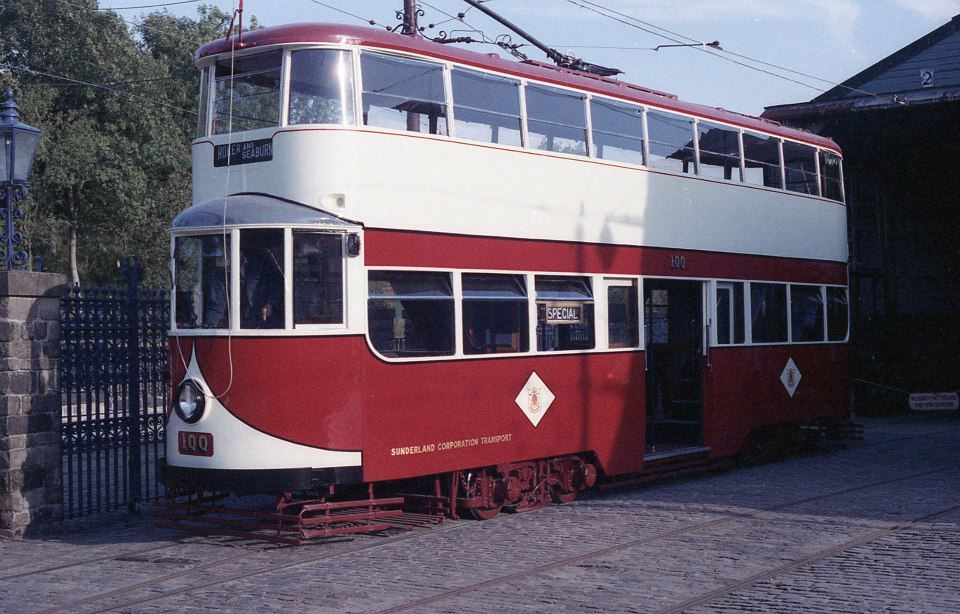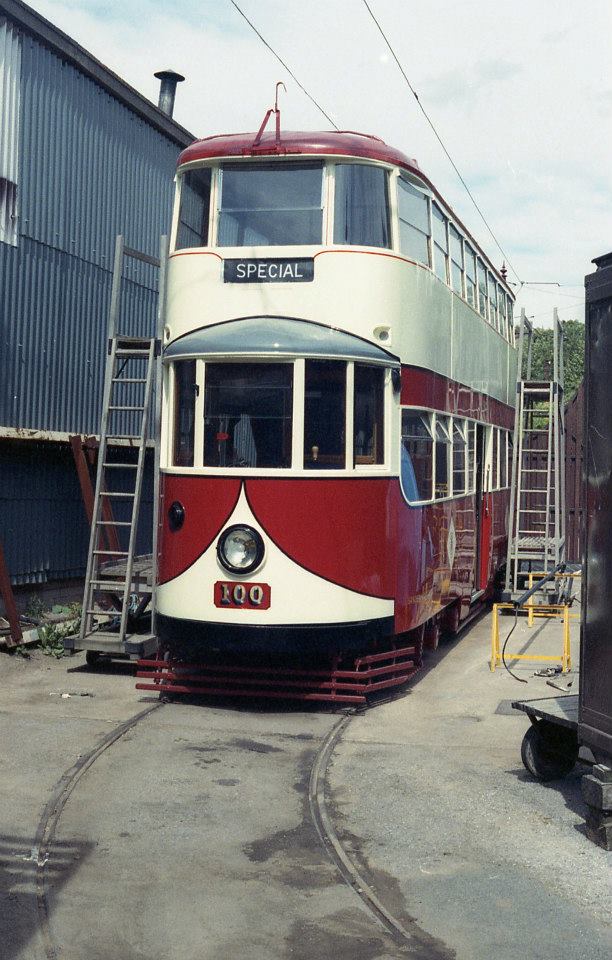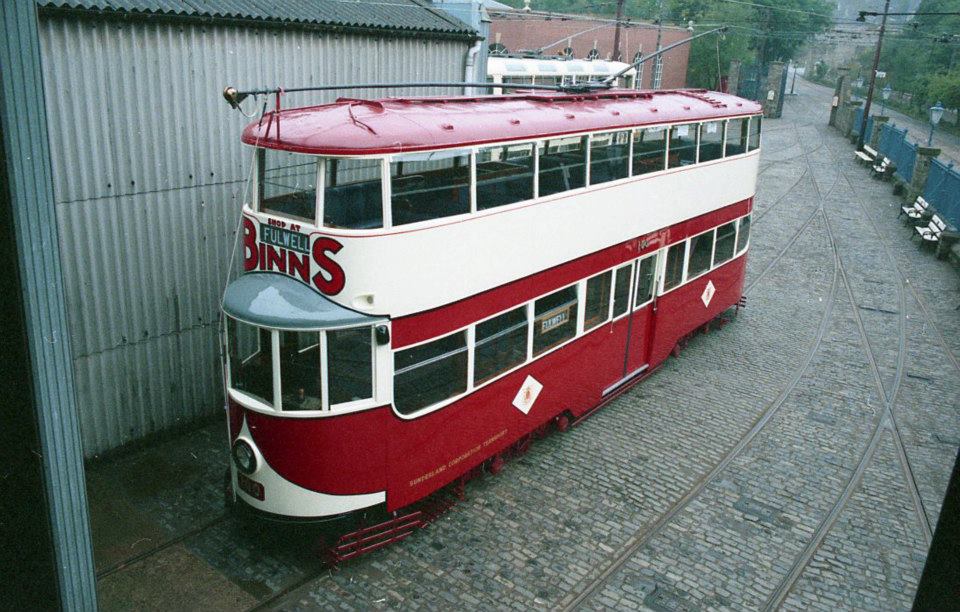Metropolitan Electric Tramways 331 is a tram which is no doubt very familiar to most readers of this website, as it is a regular performer on the tramway at Crich. However, when it was first restored at the museum, it initially ran in its latter day guise as Sunderland 100 for a short period of time – and this week, our occasional series of archive images shows the tram in this condition, fresh from the Crich workshop.
MET 331 had, of course, had a fairly short lifespan in London prior to being withdrawn; the need for all trams to be fitted with conduit ploughs spelled the end of its career in the city, as its lower centre entrance made it impossible for it to be converted in this way. Fortunately, it was sold for further service in Sunderland, which allowed it to survive into preservation. After many years spent languishing in the depots at Crich, its salvation came from the Gateshead Garden Festival, who provided funding for three local trams to be overhauled in readiness for operation on a short tramway at the event. This allowed 331 to be extensively restored, emerging in August 1989 as Sunderland 100 and proving to be instantly popular at the museum.
Sadly, commercial sponsorship led to the Garden Festival organisers insisting on a further repaint for 100, so the ornate dark red and white Sunderland livery was replaced by a blue and white all-over advert for British Steel after just a few weeks in service. Soon after the garden festival ended and the tram returned to Crich, it was repainted as MET 331, and has operated in this guise ever since. It is sometimes suggested that the car should be repainted in Sunderland livery at some point in the future, maybe sporting a pantograph as it ran in Sunderland? For now though, we take you back to the summer of 1989 to see just how magnificent the unique Feltham car looked in its Sunderland colours!
Our grateful thanks go to Andy Bailey for supplying these fantastic pictures which we hope you will enjoy.

Sunderland 100 seen emerging from the workshop at Crich, on what appears to be a test run. Here, the tram had not yet received the familiar 'Shop At Binns' slogans, but otherwise looks complete with its fleet numbers and diamond crests.

Sunderland 100 seen standing in the washbay. This area is now occupied by the workshop extension although trams continue to be cleaned here even today.

A final view of Sunderland 100, seen outside the workshop again - but this time with its Binns adverts applied.

331 didn’t exactly “languish in the depots” until restored for the Gateshead Garden Festival. The tram was restored mechanically and electrically in the TMS Workshop long before the garden festivals were ever heard o. 331 ran successfully on test for the first time at Crich on Friday 23/06/72 and on several occasions afterwards, demonstrating its eligibility for full restoration at the earliest opportunity. That was what enabled it to be selected for Gateshead. I am grateful for this opportunity to set the record straight.
Great photographs. I remember 1989 at Crich did not go to event in Gateshead but managed to obtain some stills of 100 but much more film footage in Sunderland colours.
Just to tie together two current British Trams Online News items (this one and the “Metrolink T68 1025 becomes twelfth to be withdrawn – with a twist!” one), 331 was originally fitted with bolster bearer rollers which nestled into shallow indentations in the quadrant plates on straight track. When entering curves the rollers rode easily out of the indentations to permit the bogies to rotate freely. Yaw dampers do the same job on railways today. The intention in 1930 was to promote steady running at high-speed – 331 was fitted with auto weak field equipment to increase its top speed. Neither the bolster rollers, the indented quadrant plates or the auto weak field equipment have (to the best of my knowledge) been restored or enabled at Crich. Neither has the power doors facility.
In Sunderland the tram ran with the bolster roller pins worn down so badly that the rollers sat immobile in the bottom of the trunnions. Consequently the car frequently derailed on entering curves and points, and still did so at Crich until new rollers were fitted in 1972, only to be discarded later.
The relevance to Metrolink is that the M5000s (and other modern trams) might benefit from a modern equivalent of the MET anti-hunting device – such as switchable yaw dampers. Switchable because they may need disabling in on-street mode, otherwise they might fetch the trams off the track on entering sharp curves and points, just as in Sunderland.
Another, perhaps more fanciful, temporary solution may be to allow the flanges on the M5000s to “grow” so that they engage the undamaged gauge face below the T68s’ cyclic sidecutting scars – that is if no other technical issues were raised by the deeper flanges.
This centre-entrance tram really looked good in that livery, without the ugly Binns advert.The upswept front panel suits the Feltham cab end.
David,
Are you sure you have got the correct tram when you state ‘The tram was restored mechanically and electrically in the TMS Workshop long before the garden festivals were ever heard o. ‘ I remember doing a lot of work on the bogies in the late 80’s. Some facts stick in my mind. The brake gear alone was very worn and there were 150 holes that I drilled, reamed and bushed out to remove the considerable wear along with 50 new pins made to suit. The underframe was also slightly bent. A while ago I found some pictures I took of me setting up for machining the new brake shoe holders.
The problems with the rollers on the quadrant plates as we found out after restoration, was that dirt got trapped between the rollers and plates, stopping the rollers from rotating. This in turn led to flats on the rollers and a high loading on such a small area making it harder for the bogies to rotate and also wearing into the quadrant plates. So after a short while the rollers were removed and quadrant plates substituted making the car better riding and easier to go round corners.Hope this clarifies some points